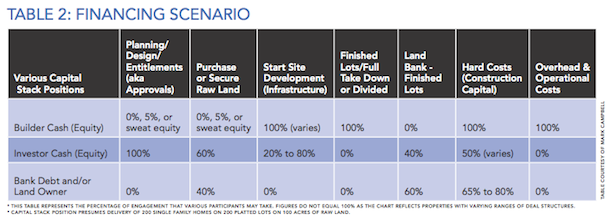Competition molds people and markets into better shape physically, financially, and behaviorally. If you agree, then I recommend tapping into the mechanisms of competition by perfecting the process of securing capital. Specifically, find an alternative to your bankers and start dancing with more investors.
Equity investors play an important role in not only securing deals but with providing quick funding when unexpected financial deadlines occur. Banks, on the other hand, move slowly and their delays can affect the viability of a deal.
Like dancing partners, both builder and investor should work in synch without stepping on each other’s toes. A winning combination can yield great growth opportunities for your company and financial returns for your investors. Just as with designing, estimating, and production, winning over investors can be planned and executed. Most large builders already have teams of people dedicated to analyzing their financial needs and courting investors. Small- and medium-sized builders also must dedicate time and attention toward building their available financing sources within their capital stack.
Set aside two to three hours every week for raising capital. Dedicate resources to finding equity partners. Most equity relationships develop through referrals and word of mouth.
Remember, competition is your friend in a recovering market. If you cannot perform the functions required to secure diverse funding sources, then find assistance so that you can.
The steps for finding potential investors are as follows:
• Conduct research and find banks, equity funds, friends, and family that can provide capital. Work with trusted advisors such as insurance brokers, attorneys, and CPAs to meet potential equity partners.
• Make sure you are on the same playing field. Risk and reward expectations must be aligned or fairly close.
• Do not immediately reject equity investors who require 15-to 25-percent returns. They may be providing just a small percentage of capital, but their investment will diversify your source of funds. Additionally, they can backstop any disputes you might have with your other sources of capital.
Preparing for the Investor
The New Dance Rules
Builders must acknowledge that new ground rules have become glaringly obvious in the capital arena. My clients and I have endured endless disasters since 2007, running the gauntlet of equity deals, bank loans, and builder equity capital restructuring. This article is too short to explain why the capital landscape has changed, so trust me on this. I can refer you to many builders who will attest to these points:
- Diversify your source of funds to three or more at all times.
- Do not agree to syndicated lines of credit with two or three banks unless you are very sure of your terms and how the lead bank functions.
- Do not put all your operating capital in the same bank that is holding your loans.
Relying on winning that handshake deal after a round of golf won’t cut it these days for securing capital. This task requires preparing an investor package that will properly communicate your opportunity and capabilities to financiers. Have a leader—whether it is you or a collaborative effort with a funding professional—to help you create professional cash flows and projections. You must be able to prove with your own facts that your deal will produce the results you are promoting. Many of us know metrics in our heads, and we can rough out deals on napkins. But if you want a third party to jump in, formalize and backup your assumptions.
After producing a number of investor packages, my clients and I have been complimented most often on investor packages that followed this outline:
1. Submarket conditions (market comps matter).
2. Overview of the company’s financial condition
3. Investment summary
4. Key issues facing the firm and where opportunities exist
Information needs to be concise and to the point. Investors look at massive amounts of data and deals. So keep your executive summary to two pages followed by the detailed schedule mentioned above. Explain very directly why any investor should care to be involved with you and your company.
Exhibits at the back of the package should be used to present descriptions about the firm’s foundational skills and abilities. Doing so allows you to provide due diligence-type details without distracting from the pressing issues of the deal you are selling. Typically, I like to put in a historical overview of the company, key operating metrics, and additional market data that involves the surrounding markets. I’ll also include a comparative summary relative to other housing markets (for example, why Denver rocks and St. Louis is slowly recovering).
Make sure in the introduction that you specifically ask for what you want. Don’t beat around the bush. Go for it! Show clearly that you know what you need, when you need it, and how this investment will best fit your operational goals. Don’t waste investors’ time or yours by being unprepared and unprofessional.
Step, Step, Turn
Perhaps the most important principle of courting investors and grasping deal structures is this one: Don’t rule out working with an investor by making assumptions that are not factually based. For example, in Table 1, if the builder compares the perceived cost of capital against the actual cost, he can see that partnering with an equity investor is cheaper than he initially thought. The cost of capital is less expensive because the investor diversifies the risk assumed by the builder. Even though the investor is commanding a higher rate of return, the cost of money is lower than bank debt because the investor is taking a smaller portion of the total funding.

Keep competition in your capital stack. This approach is good for you and your capital position because bankers, friends, and equity guys all know you can substitute someone else as a financing partner if you are performing as projected. Over time you can negotiate down the cost of capital as the market improves and as you verify your assertions by meeting or exceeding projections.
Also, don’t let financial jargon make you insecure. You’re the one paying for the capital, so ask questions. What do you mean by multiples? What is capital stack? Why do I need collateral? What do ownership positions and senior or junior debt mean? Don’t agree to something you don’t understand. Get legal advice as needed. Also meet with your potential investors and enhance your understanding of their requirements.
As the market normalizes, deal structures will be forced to become less expensive and more debt-driven (this point is debatable but humor me here). So, I recommend you keep three or more sources of capital even though you will be tempted to optimize your profits (aka greedy). Diversification is a good thing, and the lack of protective action can get you into more trouble than imaginable (You buy the beer, I’ll tell you sagas of a home-building management consultant).
Aligning the speed of your operation in a symbiotic way with the speed of the investor is critical. Given that many land and business transactions have very hard deadlines (or else the deal is lost), having a poorly performing partner on either side of the transaction can result in lost opportunities and hard feelings. Avoid this scenario; it is not fun. Also, make sure your urgency is the same as your investor’s urgency. Poor planning or management is not a reason to create an emergency for your transaction partner. Do your best to be realistic about the time and material required to perform the necessary work for closing the transaction.
Obviously, builders understand the residential home production pipeline. We work from the raw land purchase or purchase options, through planning, design, and approvals, to site development, and then to the delivery of finished lots and finally the construction of houses. Some investors are not familiar with this process. Determine the section(s) of the pipeline with which your potential investor is most comfortable. This knowledge is important because timeliness and learn- ing curves do not coexist well. The structure of builder equity, bank debt, and investor equity is highly variable as you move through the production and delivery of homes. There are numerous firms that specialize in such financing. An evolution of the capital stack through the production pipeline, as shown in Table 2, is somewhat typical although deals are highly varied and are absolutely dependent on the participants.

Legacy issues, such as the loan you have yet to restructure or pay off, matter. Do you have any unresolved issues with your banks, creditors, or others? Now is the time to resolve them. If needed, get a mediator to help find a resolution. The sooner the better, otherwise you will be constraining your opportunities for financing and your chances for prosperity.
Like it or not, the political economy is the water in which we are forced to swim. All sector participants must be vigilant for events that can impact your business whether they originate from social, political, economic, national defense, or environmental causes. The time is right for a steady housing recovery but be thoughtful and opportunistic. Our business is a submarket regional industry with national implications, as we all have learned. Opportunities to grow your company, secure capital, and be financially proactive are here. Which actions will you take to achieve success?
As with closing on a home, the capital deal is not done until you have funding. The funding structure should be executed in an efficient, easily verified, and managed way that is amiable to both parties. If you do not have a system or the staff to manage such reporting, then establish them. Remember everything you do in the process of bringing investors onboard reflects positively or negatively on your operations and on the investor. After all, this process is “the dance.” Both parties perform well when they know when and where the other will move. Doing the Jitterbug at high speed is fun, and once you’ve learned the moves, you and your investors can hit the dance floor again and again.
Noelle Tarabulski is CEO of Builder Consulting Group of Lakewood, Colo., a management consulting firm dedicated to builders and developers since 1991. She can be reached at noellet@buildertools.com.
Mark D. Campbell is CEO of Campbell Consulting Partners of Centennial, Colo., a special situations financial advisory firm dedicated to all sectors of the real estate industry. He can be reached at mcampbell@campbellconsultingpartners.com.









